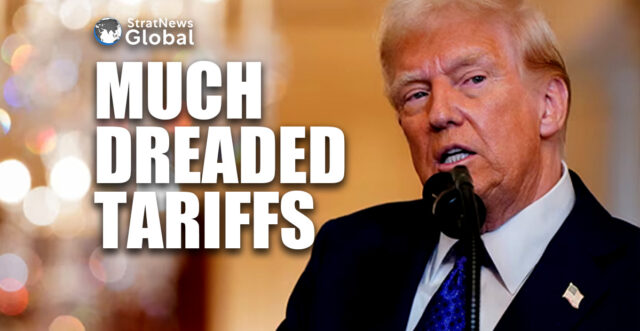U.S. President Donald Trump has ordered 25% tariffs on Canadian and Mexican imports and 10% on goods from China starting Tuesday and declared that they would remain in place until a national emergency over the drug fentanyl and illegal immigration to the U.S. ends.
Energy products from Canada will have only a 10% duty, but Mexican energy imports will be charged the full 25%, officials told reporters.
A White House fact sheet on the duties said they would remain in place “until the crisis alleviated.”
It did not however provide details on what actions the three countries would need to take to win a reprieve.
The move follow through on a repeated threat Trump has made since shortly after winning last year’s presidential election, and they likely will trigger retaliation and risk igniting a trade war that could cause broad economic disruption for all countries involved.
Tariff collections are set to begin at 12:01 a.m. EST (0501 GMT) on Tuesday, according to Trump’s written order.
But imports that were loaded onto a vessel or onto their final mode of transit before entering the U.S. prior to 12:01 a.m. Saturday would be exempt from the duties.
Trump has declared national emergency under the International Emergency Economic Powers Act and the National Emergencies Act to back the tariffs, which allows the president sweeping powers to address crises.
The White House officials said there would be no exclusions from the tariffs.
Moreover, in the case of Canada specifically, they said the “de minimis” U.S. tariff exemption for small shipments under $800 would be canceled.
Trump, who golfed at his Mar-a-Lago estate in Florida on Saturday before signing the order, was not scheduled to speak to reporters about the tariffs.
Trump set the February 1 deadline to press for strong action to halt the flow of the opiate fentanyl and precursor chemicals into the U.S. from China via Mexico and Canada, as well as to stop illegal immigrants crossing U.S. borders.
Less than two weeks into his second term, Trump is upending the norms of how the United States is governed and interacts with its neighbors and wider world.
On Friday, he pledged to proceed with the levies despite acknowledging they could cause disruption and hardship for American households.
A model gauging the economic impact of Trump’s tariff plan from EY Chief Economist Greg Daco suggests it would reduce U.S. growth by 1.5 percentage points this year, throw Canada and Mexico into recession and usher in “stagflation” at home.
“We have stressed that steep tariff increases against U.S. trading partners could create a stag flationary shock – a negative economic hit combined with an inflationary impulse – while also triggering financial market volatility,” Daco wrote on Saturday.
That volatility was evident on Friday, when the Mexican peso and Canadian dollar slumped after Trump vowed to fulfill his threats.
U.S. stock prices also fell and Treasury bond yields rose.
(With inputs from Reuters)
Delhi based journalist pickled in journalism. Have reported from nine world capitals and almost all parts of India. Over the last three decades, I have worked for India’s mainstream English dailies and contributed to All India Radio, Doordarshan and Women’s Feature Service. Also worked for international media including Japan’s leading newspaper, The Asahi Shimbun and done assignments for The Sunday Times, London, The Telegraph, The Guardian and the Canadian Broadcasting Corporation. Worked in the Embassy of France in New Delhi and can speak French to save my life. Write on Diplomacy, Politics and the social sector. Love Nature, heritage, Nature, animals and vintage cars. Enjoy cycling and playing badminton.





